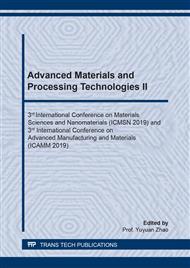[1]
A.K. Gain, T. Fouzder, Y.C. Chan, A. Sharif, N.B. Wong and W.K.C. Yung: J. Alloys Compds. Vol. 506 (2010), p.216.
Google Scholar
[2]
G. Zeng, S. Xue, L. Zhang, L. Gao, Z. Lai and J. Luo: J. Mater. Sci. Vol. 22 (2011), p.1101.
Google Scholar
[3]
L. Zhang, S. Xue, L. Gao, Z. Sheng, H. Ye, Z. Xiao, G. Zeng, Y. Chen and S. Yu: J. Mater. Sci. Vol. 21 (2010), p.1.
Google Scholar
[4]
S.K. Seo, S.K. Kang, D.Y. Shih and H.M. Lee: Microelectron. Reliab. Vol. 49 (2009), p.288.
Google Scholar
[5]
K. Nogita: Intermetallics Vol. 18 (2010), p.145.
Google Scholar
[6]
S.A. Belyakov, J.W. Xian, K. Sweatman, T. Nishimura, T. Akaiwa and C.M. Gourlay: J. Alloys Compds. Vol. 701 (2017), p.321.
DOI: 10.1016/j.jallcom.2016.12.404
Google Scholar
[7]
P.T. Vianco and J.A. Rejent: J. Electron. Mater. Vol. 28 (1999), p.1127.
Google Scholar
[8]
Y. Liu, F.L. Sun, Y. Liu and X.M. Li: J. Mater. Sci. Mater. Electron. Vol. 25 (2014), p.2627.
Google Scholar
[9]
J. Zhao, L. Qi, X.M. Wang and L. Wang: J. Alloy Compds. Vol. 375 (2004), p.196.
Google Scholar
[10]
P.T. Vianco and J.A. Rejent: J. Electron. Mater. Vol. 28 (1999), p.1138.
Google Scholar
[11]
J. Shen, Y. Pu, D. Wu, Q. Tang and M. Zhao: J. Mater. Sci. Mater. Electron. Vol. 26 (2015), p.1572.
Google Scholar
[12]
X. Hu, Y. Li and Z. Min: J. Alloys Compds. Vol. 582 (2014), p.341.
Google Scholar
[13]
U.R. Kattner and W.J. Boettinger: J. Electron. Mater. Vol. 23 (1994), p.603.
Google Scholar
[14]
A.A. El-Daly, A.M. El-Taher and S. Gouda: Mater. Design Vol. 65 (2015), p.796.
Google Scholar
[15]
X. Hu, Y. Li, Y. Liu and Z. Min: J. Alloys Compds. Vol. 625 (2015), p.241.
Google Scholar
[16]
J.X. Wang, M. Yin, Z.M. Lai and X. Li: Trans. China Weld. Inst. 3Vol. 2 (2011), p.69.
Google Scholar
[17]
J.W. Yoon, Y.H. Lee, D.G. Kim, H.B. Kang, S.J. Suh, C.W. Yang, C.B. Lee, J.M. Jung, C.S. Yoo and S.B. Jung: J. Alloys Compds. Vol. 381 (2004), p.151.
Google Scholar
[18]
M.I.I Ramli, N. Saud, M.A.A. Mohd Salleh, M.N. Derman and R. Mohd Said: Microelectron. Reliab. Vol. 65 (2016), p.255.
Google Scholar


